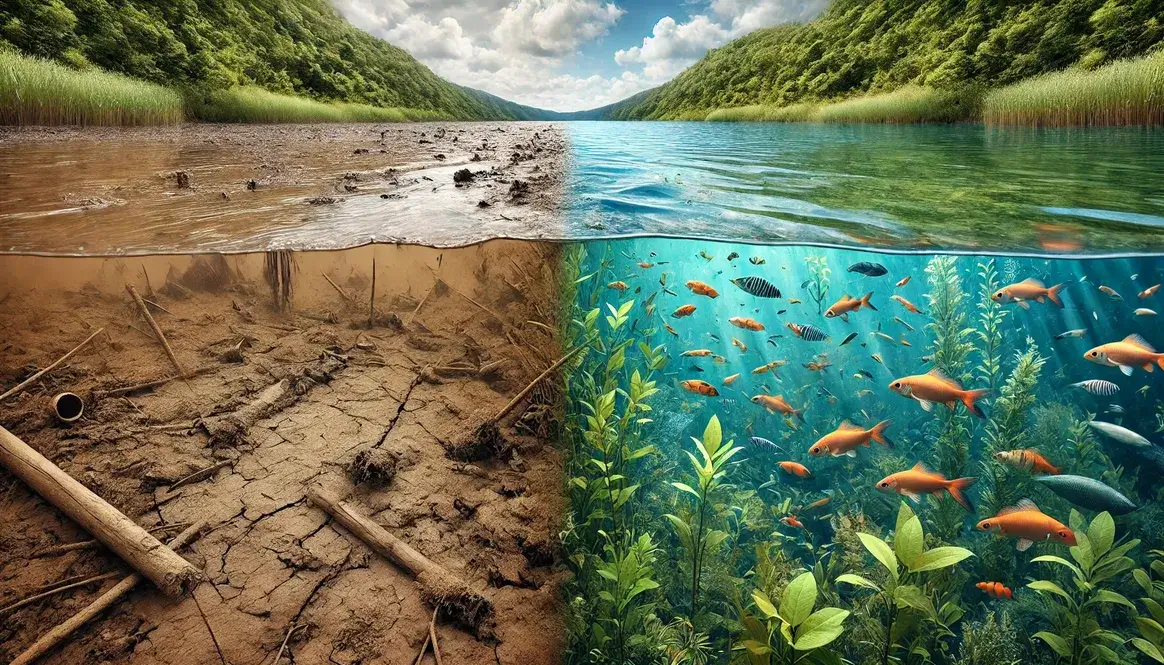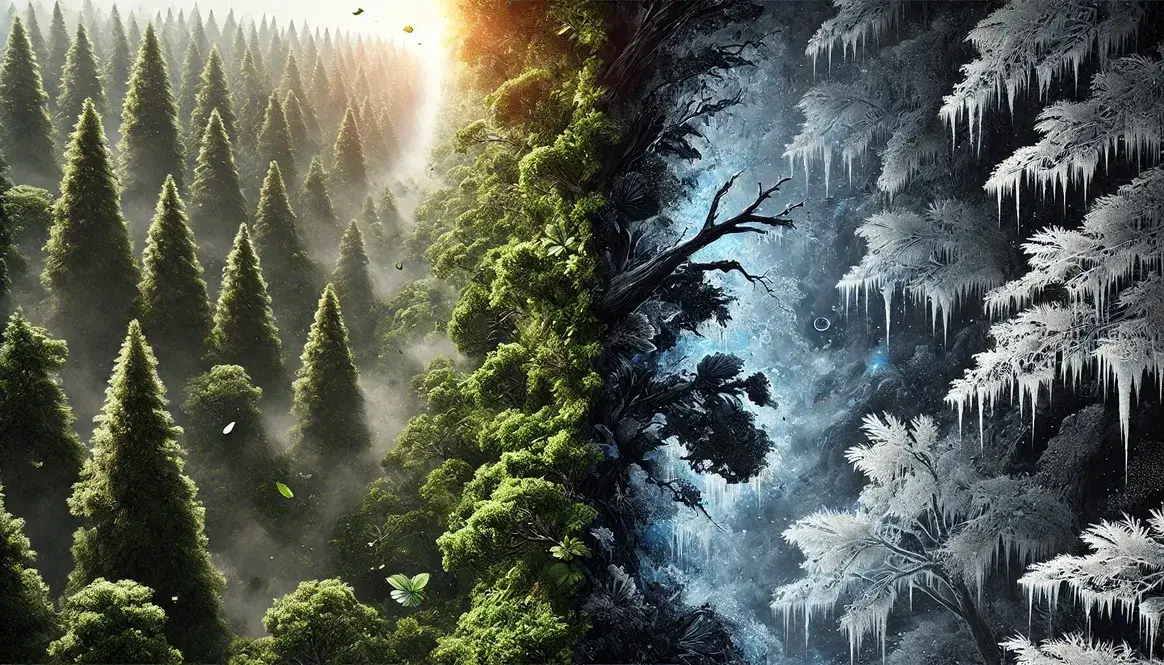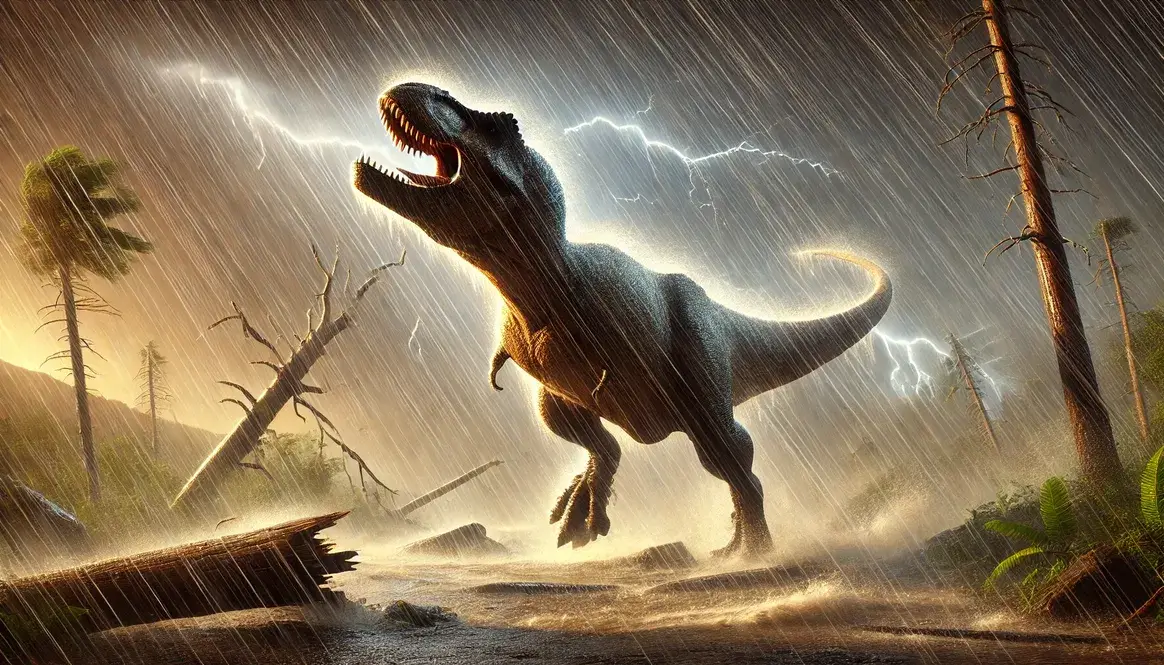What happened to rivers and lakes when the dinosaurs disappeared? When a massive asteroid struck Earth 66 million years ago, it affected more than just the large reptiles. Freshwater environments underwent significant changes too. Let’s explore how these water bodies transformed and eventually recovered from this major event.
| Key Changes in Rivers and Lakes After Dinosaur Extinction | |
|---|---|
| Initial Effects | Excess sediment, water chemistry shifts, temperature changes |
| Surviving Organisms | Freshwater fish, amphibians, certain reptiles |
| Time to Recover | Several hundred to thousands of years |
| Lasting Changes | New species adjustments, different river paths |
The Impact of the K-Pg Event on Freshwater Systems
The asteroid collision that marked the end of the dinosaur era had immediate and severe effects on rivers and lakes. Within a short time, these once-clear water bodies became muddy and filled with debris.
Picture rivers suddenly turning into dirty, polluted streams and lakes becoming clogged with sediment. That’s what occurred right after the asteroid impact. The collision launched large amounts of dust and ash into the air, which then fell into water bodies everywhere.
These alterations happened rapidly. In a matter of days or weeks, rivers and lakes changed from clean, thriving ecosystems to murky, challenging environments. Fish that previously swam in clear waters now struggled in thick, sediment-filled streams. Vegetation along lake shores became buried under layers of ash and rock.
Yet, life persisted. Even in these difficult conditions, some organisms found ways to survive. The story of rivers and lakes after the dinosaur extinction involves destruction, endurance, and eventual renewal.
Rivers and Lakes After Dinosaur Extinction: Initial Changes
The first few years after the asteroid impact brought dramatic changes to freshwater environments. Let’s explore how rivers and lakes transformed during this period.
Sediment Overload
The asteroid impact launched enormous amounts of dust, ash, and rock into the atmosphere. This material didn’t stay in the air for long. It fell back to Earth, with much of it ending up in rivers and lakes. The result? Water bodies choked with sediment.
- Rivers became muddy and thick
- Lakes turned cloudy and filled with debris
- Water flow patterns changed as sediment built up
This sediment overload made life difficult for many aquatic organisms. Fish found it hard to breathe, and plants struggled to get enough sunlight. The Cretaceous period climate had been quite different, and life wasn’t prepared for such rapid changes.
Chemical Alterations
The impact didn’t just add physical material to the water. It also changed the chemical makeup of rivers and lakes.
- Increased acidity: The asteroid impact released sulfur compounds, making water more acidic.
- Higher metal content: Rocks pulverized by the impact released metals into the water.
- Reduced oxygen: Decaying matter used up much of the oxygen in the water.
These chemical changes made survival challenging for many aquatic species. Only the most adaptable could endure these new conditions.
Temperature Fluctuations
The asteroid impact had a significant effect on Earth’s climate, which in turn affected water temperatures. The dust and debris in the atmosphere blocked sunlight, leading to a period of global cooling. This cooling had several effects on rivers and lakes:
| Effect | Description |
|---|---|
| Surface water cooling | Lakes and rivers became colder, especially near the surface |
| Reduced evaporation | Less water evaporated, affecting the water cycle |
| Changed mixing patterns | Temperature differences in lakes altered how water layers mixed |
These temperature changes disrupted the delicate balance of freshwater ecosystems. Species accustomed to warmer waters struggled to survive, while those adapted to colder conditions found new opportunities. The Arctic dinosaurs might have been better prepared for these colder temperatures, but even they faced challenges in the rapidly changing environment.
Surviving Species in Freshwater Environments
While many species vanished during the mass extinction, some aquatic life forms managed to survive in rivers and lakes. These resilient creatures became the ancestors of many freshwater species we see today.
Resilient Aquatic Life
Despite the harsh conditions, several types of aquatic organisms survived:
- Freshwater fish:
- Gars
- Bowfins
- Primitive catfish
- Amphibians:
- Salamanders
- Frogs
- Reptiles:
- Turtles
- Crocodilians
- Invertebrates:
- Mollusks (snails and mussels)
- Crustaceans (crayfish)
- Insects (water striders, diving beetles)
These survivors faced a world very different from the one they knew before. The Cretaceous ocean currents had changed, affecting even inland water systems. Yet, these species found ways to endure.
Adaptations for Survival
How did these species manage to survive when so many others perished? They had several tricks up their sleeves:
Respiratory Adaptations
Some fish, like gars, had the ability to breathe air as well as extract oxygen from water. This dual respiratory system allowed them to survive in waters with low oxygen levels.
Dietary Flexibility
Many surviving species were opportunistic feeders. They could eat a variety of food sources, which proved crucial when their usual food became scarce. For example, some turtles could switch between plant matter and small animals depending on what was available.
Temperature Tolerance
Species that could withstand a range of temperatures had an advantage. Crocodilians, for instance, can slow their metabolism in colder waters, allowing them to survive with less food.
Protective Shells and Scales
Creatures with hard outer coverings, like turtles and gar fish, had some protection against the harsh, debris-filled waters. Their armor also helped them retain moisture if water levels dropped.
Reproductive Strategies
Some survivors, particularly amphibians, could lay large numbers of eggs. This strategy increased the chances that at least some offspring would survive to adulthood.
These adaptations allowed certain species to weather the storm of extinction. As conditions slowly improved, these hardy survivors became the foundation for new, diverse ecosystems in rivers and lakes.
The ability of these species to adapt quickly was crucial. Unlike the gradual Cretaceous climate changes, the post-impact changes happened rapidly. Only the most adaptable could survive such swift transformations in their watery homes.
Short-Term Effects on River and Lake Ecosystems
The changes in rivers and lakes after dinosaur extinction weren’t limited to water quality and temperature. The entire ecosystem experienced significant disruptions, altering the way life functioned in these aquatic environments.
Food Web Disruptions
The extinction event caused major upheavals in aquatic food chains. With many species disappearing, the carefully balanced relationships between predators and prey were thrown into chaos.
- Loss of Primary Producers: Many aquatic plants and algae died off due to reduced sunlight and changed water conditions. This caused a shortage of food for herbivorous species.
- Collapse of Specialized Feeders: Animals with specific diets suffered greatly. For example, fish that relied on certain types of plankton had to adapt or perish.
- Predator-Prey Imbalances: With fewer prey species, some predators faced starvation. Conversely, surviving prey species sometimes thrived without their usual predators.
These disruptions created a domino effect throughout the ecosystem. Species that could adapt to new food sources had a better chance of survival. This period of change likely spurred rapid evolution in many aquatic species, as they adjusted to new roles in the altered food web.
Water Flow Changes
The impact event didn’t just affect the water itself; it also changed the land around rivers and lakes. These landscape alterations had significant effects on how water moved through the environment.
Altered River Courses
The asteroid impact and subsequent climate changes reshaped the land. Landslides, earthquakes, and altered rainfall patterns changed the courses of many rivers. Some examples of these changes include:
- New rapids and waterfalls formed where land had shifted
- Rivers changed direction, sometimes joining with other waterways
- Some rivers became wider and slower, while others became narrower and faster
Sedimentation Effects
The increased sediment in the water had long-lasting effects on river and lake structures:
| Effect | Description |
|---|---|
| Lake Shallowing | Sediment buildup made many lakes shallower |
| River Delta Changes | Increased sediment altered the shape and size of river deltas |
| New Islands | Sediment deposits created new islands in rivers and lakes |
These changes in water flow had profound effects on aquatic habitats. Species had to adapt to new water speeds, depths, and structures. The altered landscapes also affected how nutrients were distributed through water systems, further impacting the recovering ecosystems.
The changing water patterns likely influenced how surviving species moved and migrated. Just as dinosaur climate migrations had occurred before the extinction, aquatic species now had to navigate new waterways and adapt to changed habitats.
These short-term effects set the stage for the long-term evolution of river and lake ecosystems in the post-dinosaur world.
Recovery of Freshwater Habitats
After the initial chaos, rivers and lakes began a slow journey of recovery. This process took thousands of years, but gradually, these water bodies transformed back into thriving ecosystems.
Gradual Clearing of Waters
Over time, the murky, debris-filled waters started to clear. This happened through several natural processes:
- Settling: Heavier particles sank to the bottom, forming new sediment layers.
- Flushing: Flowing water carried away smaller particles.
- Filtration: Surviving organisms, like mollusks, helped filter the water.
As the water cleared, sunlight could once again penetrate deeper into lakes and rivers. This was crucial for the revival of aquatic plant life and the animals that depended on it.
Reestablishment of Plant Life
The return of aquatic plants was a key step in the recovery of freshwater ecosystems. Plants played several vital roles:
- Oxygen production: Through photosynthesis, plants reintroduced oxygen into the water.
- Habitat creation: Plants provided shelter and breeding grounds for animals.
- Food source: They became a primary food source for many species.
- Water purification: Plants helped filter out remaining pollutants.
Different types of plants returned at different rates. Fast-growing algae were among the first to reappear, followed by more complex aquatic plants. This gradual return of plant life mirrored the way Cretaceous plants adapted to changing conditions before the extinction event.
Return of Diverse Animal Life
As plant life reestablished and water conditions improved, animal life in rivers and lakes became more diverse. This process unfolded over thousands of years:
Early Stages
- Hardy species that survived the extinction began to thrive and expand their populations.
- Invertebrates like insects and crustaceans multiplied quickly, providing food for larger animals.
Middle Recovery
- Fish populations grew more diverse as they adapted to fill new ecological niches.
- Amphibians returned to the water edges, contributing to both aquatic and terrestrial ecosystems.
Later Stages
- Larger predators, like crocodilians, became more common as prey populations increased.
- New species evolved to take advantage of the changed environments.
This table shows the gradual return of biodiversity in freshwater ecosystems:
| Time After Extinction | Biodiversity Level | Examples of Returning Life |
|---|---|---|
| 0-1000 years | Low | Algae, insects, hardy fish |
| 1000-10,000 years | Moderate | Diverse fish, amphibians, aquatic plants |
| 10,000+ years | High | Complex food webs, new species |
The recovery of freshwater habitats wasn’t uniform across the globe. Factors like latitude, altitude, and local geology influenced how quickly and completely ecosystems bounced back. This variability created a patchwork of recovery, much like how Cretaceous weather patterns varied across the planet before the extinction.
As rivers and lakes recovered, they became the foundation for the diverse freshwater ecosystems we see today. The long process of recovery shaped the evolution of aquatic life, leading to the rich biodiversity found in modern rivers and lakes.
Long-Term Changes in Rivers and Lakes
The extinction event triggered a series of long-lasting changes in freshwater ecosystems. Over millions of years, these changes shaped the rivers and lakes we see today.
New Species and Adaptations
As rivers and lakes recovered, surviving species evolved to fill new ecological niches. This process, known as adaptive radiation, led to an explosion of new species and adaptations.
Some examples of these evolutionary changes include:
- Fish diversification:
- Development of new feeding strategies
- Adaptations for different water depths and flow rates
- Evolution of unique camouflage patterns
- Amphibian specializations:
- New breeding behaviors
- Adaptations to varying water quality
- Evolution of toxins for defense
- Aquatic plant innovations:
- New root systems for stability in changing water levels
- Evolved leaf shapes for better light capture
- Adaptations for pollination in aquatic environments
These adaptations weren’t limited to physical changes. Behavioral adaptations also played a crucial role. For instance, some fish species developed new mating rituals to attract partners in clearer waters, while others changed their hunting strategies to suit the altered aquatic landscape.
The long-term evolution of freshwater species was influenced by factors similar to those that affected Cretaceous carbon levels, such as changes in atmospheric composition and global temperature shifts.
Altered River Courses
The landscape changes caused by the extinction event had long-lasting effects on river patterns. Over time, these alterations became permanent features of the post-extinction world.
New Drainage Patterns
Rivers found new paths across the changed landscape:
- Some rivers merged, creating larger, more powerful waterways
- Others split into smaller streams, forming new wetland areas
- Changes in elevation led to the formation of new rapids and waterfalls
Erosion and Deposition
The process of erosion and sediment deposition reshaped river valleys:
| Process | Effect on Rivers |
|---|---|
| Erosion | Deepened river channels, created new canyons |
| Deposition | Formed new floodplains, built up deltas |
These processes were similar to those that shaped rivers during the Cretaceous period, but they occurred at an accelerated rate due to the post-impact landscape instability.
Climate-Driven Changes
Long-term climate shifts also influenced river courses:
- Changes in rainfall patterns altered river volumes and flow rates
- Glacial periods caused some rivers to change course or disappear entirely
- Rising sea levels in warmer periods changed the length and characteristics of rivers near coasts
These climate-driven changes in river courses were part of a larger pattern of global climate fluctuations. Just as Earth’s orbital effects influenced the Cretaceous climate, similar factors continued to shape the post-extinction world.
The altered river courses created new habitats and migration routes for aquatic species, further driving the evolution and diversification of life in freshwater ecosystems. Today’s rivers and lakes are the result of these long-term changes, showcasing the remarkable adaptability of life in the face of catastrophic events.
Evidence from Sedimentary Records
Scientists have pieced together the story of rivers and lakes after dinosaur extinction by studying sedimentary records. These ancient layers of earth hold valuable clues about past environments and events.
Reading the Layers
Sediment layers act like a natural history book, with each layer representing a different period in time. Scientists use various techniques to “read” these layers:
- Stratigraphy: Studying the order and composition of sediment layers
- Paleontology: Examining fossils found within the layers
- Radiometric dating: Determining the age of sediments
By analyzing these layers, researchers can reconstruct past environments and track changes over time. For example, a layer rich in ash and impact debris marks the time of the extinction event. Subsequent layers show how rivers and lakes changed in the following years and centuries.
Key Indicators in Sediment Layers:
- Grain size: Indicates water flow strength
- Organic content: Reflects ecosystem productivity
- Fossil types: Shows which species were present
These indicators help scientists paint a picture of how freshwater environments evolved after the extinction event, much like how Cretaceous sea levels can be inferred from marine sediments.
Chemical Signatures
Chemical traces in sediments provide additional insights into post-extinction water conditions. These signatures act like fingerprints of past environments.
Some key chemical indicators include:
| Chemical Element | What It Tells Us |
|---|---|
| Iridium | Presence of asteroid material |
| Sulfur | Acidification of water bodies |
| Carbon isotopes | Changes in biological productivity |
| Oxygen isotopes | Water temperature fluctuations |
By analyzing these chemical signatures, scientists can reconstruct:
- Water acidity levels
- Nutrient availability
- Temperature changes
- Presence of pollutants
These chemical clues help fill in the gaps in our understanding of how rivers and lakes recovered after the extinction event. They provide quantitative data to support theories about environmental changes and their effects on aquatic life.
Lessons from Ancient Waterways
Studying rivers and lakes after dinosaur extinction offers valuable insights for understanding our present and future ecosystems. Here are some key takeaways:
- Resilience of Life: Despite catastrophic changes, some aquatic life forms survived and thrived, showcasing the adaptability of nature.
- Ecosystem Interconnectedness: The study reveals how changes in one part of an ecosystem can have far-reaching effects on others.
- Climate Change Impacts: The post-extinction recovery provides clues about how modern freshwater systems might respond to rapid climate change.
- Importance of Biodiversity: Diverse ecosystems proved more resilient to environmental changes, highlighting the value of biodiversity in ecosystem stability.
- Long-term Perspective: Recovery took thousands of years, reminding us that significant environmental changes have long-lasting effects.
These lessons from ancient waterways can inform our approach to current environmental challenges. By understanding how freshwater ecosystems recovered from past catastrophes, we can better prepare for and mitigate the impacts of present-day environmental changes.









